
Samzhubzê District is a district in the Tibet Autonomous Region of the China, and the administrative center of the prefecture-level city of Shigatse. Prior to 2014 it was known as the county-level city of Shigatse. It was the ancient capital of Ü-Tsang province and is the second largest city in Tibet with an estimated population of 117,000 in 2013. Samzhubzê is located at the confluence of the Yarlung Tsangpo River and the Nyang River, about 250 km (160 mi) southwest of Lhasa and 90 km (56 mi) northwest of Gyantse, at an altitude of 3,840 metres (12,600 ft).
The 10th Dalai Lama, Tsultrim Gyatso (full given name Ngawang Lobzang Jampel Tsultrim Gyatso or Tsultrim Gyatso was the 10th Dalai Lama of Tibet, and born in Litang, Kham. He was fully ordained in the Gelug school of Tibetan Buddhism, studied the sutras and tantras, had several students, and rebuilt the Potala Palace.

The 11th Dalai Lama, Khedrup Gyatso was recognized by the Ganden Tripa as the 11th Dalai Lama of Tibet and enthroned in 1842. He enlarged the Norbulingka, studied at Sera Monastery, Drepung Monastery and Ganden Monastery, and taught students.
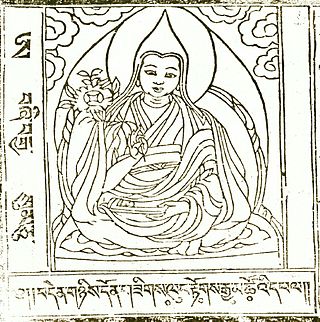
The 9th Dalai Lama, Lungtok Gyatso,, was recognized as the 9th Dalai Lama of Tibet. He was the first and the youngest Dalai Lama among four successive Dalai Lamas whom succumbed to illnesses before reaching twenty-two years of age.
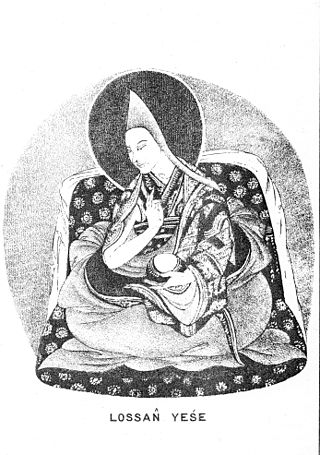
Lobsang Yeshe (1663–1737) was the fifth Panchen Lama of Tibet.

Tashi Lhunpo Monastery is an historically and culturally important monastery in Shigatse, the second-largest city in Tibet. Founded in 1447 by the 1st Dalai Lama, it is the traditional monastic seat of the Panchen Lama.

Ganden Monastery or Ganden Namgyeling or Monastery of Gahlden is one of the "great three" Gelug university monasteries located in Dagzê County, Lhasa, Tibet. The other two are Sera Monastery and Drepung Monastery. Ganden Monastery was founded in 1409 by Je Tsongkhapa Lozang-dragpa, founder of the Gelug order. The monastery was destroyed after 1959, but has since been partially rebuilt. Another monastery with the same name and tradition was established in Southern India in 1966 by Tibetan exiles.

Tsetang or Zedang, is the fourth largest city in Tibet and is located in the Yarlung Valley, 183 km (114 mi) southeast of Lhasa in Nedong District of the Shannan Prefecture in the Tibet region of China. It is the capital of Shannan Prefecture.
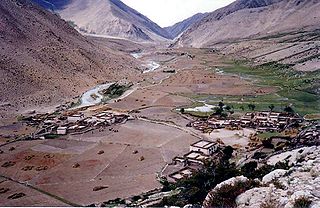
Milarepa's Cave or Namkading Cave is a cave where the Tibetan Buddhist philosopher, and Vajrayana Mahasiddha, Milarepa spent many years of his life in the eleventh century. It is located 11 kilometres (7 mi) north of the town of Nyalam at Gangka village. It is on the slope below the China–Nepal Friendship Highway and above the Matsang river in Nyalam County, Tibet.

Nechung Monastery, Nechung Gompa or Nechung Chok, is the seat of the State Oracle of Tibet. It is also referred to as Sungi Gyelpoi Tsenkar, the "Demon Fortress of the Oracle King."

Ngor or Ngor Éwam Chöden is the name of a monastery in the Ü-Tsang province of Tibet about 20 kilometres (12 mi) southwest of Shigatse and is the Sakya school's second most important gompa. It is the main temple of the large Ngor school of Vajrayana Buddhism, which represents eighty-five percent of the Sakya school.
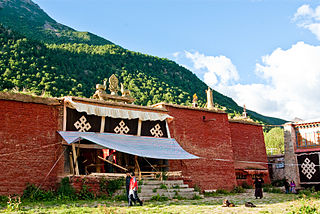
Reting Monastery is an historically important Buddhist monastery in Lhünzhub County in Lhasa, Ü-Tsang, Tibet. It is also commonly spelled "Radreng."
Dorjidak Gompa or Tupten Dorjidak Dorjé Drak Éwam Chokgar is a Tibetan Buddhist monastery and one of the Nyingma school's "Six Mother Monasteries" in Tibet. It is located in the Lhoka (Shannan) Prefecture in the south of the Tibet Autonomous Region, older southeastern Ü-Tsang.
Chokorgyel Monastery is a Buddhist monastery in Gyatsa County in Tibet, China.
Lhamo Latso or Lha-mo La-tso is a small oval oracle lake where senior Tibetan monks of the Gelug sect go for visions to assist in the discovery of reincarnations of the Dalai Lamas. Other pilgrims also come to seek visions. It is considered to be the most sacred lake in Tibet.

Tsomon Ling, Tsomonling, Tsome Ling, Chomoling is a temple in inner Lhasa, Tibet Autonomous Region, China, south of the Ramoche Temple, and on the corner of one of the main roads, Dekyi Shar Lam. It was one of the Four Royal Colleges or Regency Temples of Lhasa built during the 17th century after the Fifth Dalai Lama assumed both temporal as well as spiritual power. The other three Ling are Tengye Ling, Kunde Ling, and Drib Tsemchok Ling.

Chupzang Nunnery(Chu bzang dgon) is a historical nunnery, belonging to Sera Monastery. It is located north of Lhasa in Tibet, China. Though the site was established as a hermitage around 1665, it was converted into an exclusive nunnery in 1984 and has since grown into one of the largest nunneries in the Lhasa Valley.
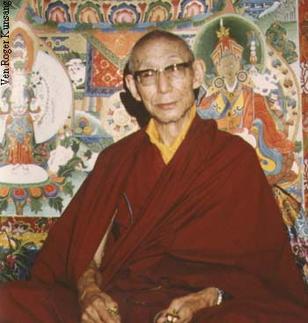
The Third Trijang Rinpoche, Lobsang Yeshe Tenzin Gyatso (1901–1981) was a Gelugpa Lama and a direct disciple of Pabongkhapa Déchen Nyingpo. He succeeded Ling Rinpoche as the junior tutor of the 14th Dalai Lama when the Dalai Lama was nineteen years old. He was also a lama of many Gelug lamas who taught in the West including Zong Rinpoche, Geshe Rabten, Lama Yeshe, Kelsang Gyatso, and Lama Zopa Rinpoche. Trijang Rinpoche's oral teachings were recorded by Zimey Rinpoche in a book called the Yellow Book.

The Shigatse Dzong, also known as Samdruptse Dzong, is located in Shigatse, Tibet, China. It is spelt Rikaze Dzong.

Yeshe Lobsang Tenpai Gonpo was the 8th Tatsag, a Tibetan reincarnation lineage. From 1789 to 1790 and from 1791 until his death in 1810 he was regent of Tibet, appointed by the Qing dynasty of China. He was the first owner of the Kundeling Monastery, founded in 1794 in Lhasa.



















